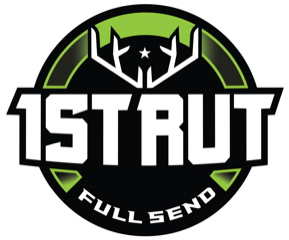1st Rut
Your Hunting Resource Home
Rut Signposts
Section #4: Whitetail Deer Communication During Rut
Whitetail Deer Rubs

Whitetail bucks communicate through both visual cues and by scent. They use branches where they deposit scent throughout the spring and summer. Following the shedding of velvet, bucks will begin making runs on trees and shrubs. While in the process of rubbing, they also deposit their scent on these markings from a gland in their forehead. Bucks are deliberate in their choice of tree and location when making a rub. In addition to serving as a signpost, it also serves to strengthen the buck’s neck in these sparring sessions. Rubs are continually made throughout the breeding season and the majority are made by mature bucks, with immature yearling bucks making very few. Both bucks and does respond to these signposts by smelling and or rubbing them.
There are trees that are rubbed year after year. These signposts may have more than one buck rubbing it, both with their foreheads for scent and with their antlers.
Note: If you look through the photo’s below, anything labeled has being in the Deer Orchard started the fall with horse fencing around it for protection. I am still not sure how they remove it, but they do.
There is always debate about the size of the deer that made a rub. It makes sense in my mind, that only a big deer could rub a big tree so I see that connection. A big deer can also rub a little tree. I shot a really nice main frame 8 point (two broken crab claws) a number of years back that was thick, and big mature deer. The only rubs I saw that year were relatively small trees like what is pictured below. If you find a big tree rubbed, that is a great sign, but if there are a number of smaller trees marked don’t be discouraged, scout the area and find out what deer live there.






Whitetail Deer Scrapes

Scrapes are another common form of communication for Whitetail Bucks’ Much like rubs, the buck is deliberate in his choice of location for this type of signpost. Once the bucks find the location, and a limb that is the right height, he will rake, lick, and rub his forehead on the overhanging branch leaving his scent. After the overhanging limb is sufficiently marked with his scent, he will begin pawing the ground directly below the limb. Once the ground is cleared, he will step over it and urinate in the circle and on his tarsal glands. While urinating he will rub his tarsal glands together allowing the urine and gland odor to fall into the scrape. This leaves a strong persistent odor in the scrape.
Note: The tarsal glands are a clump of thick hair on the inside of the deer’s leg. It plays a vital role in communicating through scent.
Scraping may begin shortly after bucks shed their velvet, but they reach their peak approximately two to three weeks before breeding activities. In general, much like rubs, the majority are made by more mature bucks. This is both a sign of dominance to other bucks and a sign of a capable mate to does.
